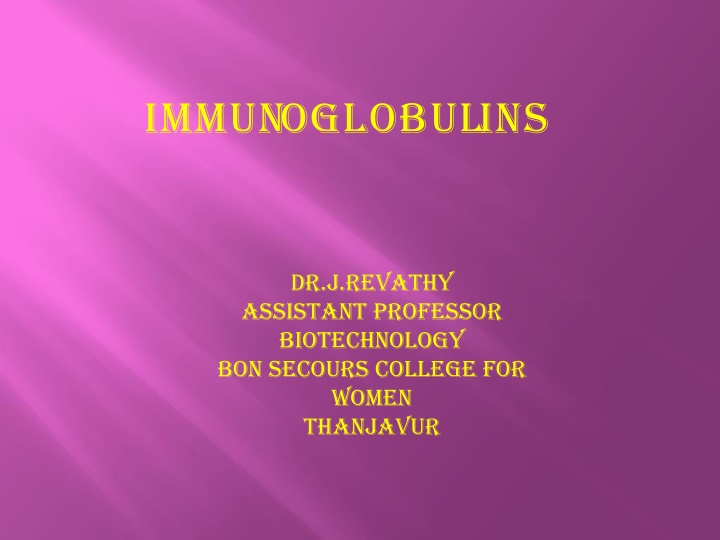
IMMUNOGLOBULINS
Explore the fascinating world of immunoglobulins - glycoproteins produced in response to antigens, playing a crucial role in the immune system. Learn about their composition, synthesis, and classification based on structure and antigenic properties.
Download Presentation

Please find below an Image/Link to download the presentation.
The content on the website is provided AS IS for your information and personal use only. It may not be sold, licensed, or shared on other websites without obtaining consent from the author. If you encounter any issues during the download, it is possible that the publisher has removed the file from their server.
You are allowed to download the files provided on this website for personal or commercial use, subject to the condition that they are used lawfully. All files are the property of their respective owners.
The content on the website is provided AS IS for your information and personal use only. It may not be sold, licensed, or shared on other websites without obtaining consent from the author.
E N D
Presentation Transcript
I m m u no g l o b u li n s Dr.J.REVATHY ASSISTANT PROFESSOR BIOTECHNOLOGY BON SECOURS COLLEGE FOR WOMEN THANJAVUR
Immunoglobulin is a glycoprotein that is made in response to an antigen and can recognize and bind to the antigen that caused its production.
Are gamma globulins Synthesized by plasma cells Constitute 25-30 % of total serum proteins Antibodies are present in serum, tissue fluids and mucosal surfaces. All antibodies are immunoglobulins, but all immunoglobulins may not be antibodies
Composed of 4 polypeptide chains. 2 identical light and 2 identical heavy chains Linked by disulphide bonds Light chains similar in all immunoglobulins Light chains occur in 2 varieties kappa and lambda Light and Heavy chains are subdivided into variable and constant region. Each heavy and light chain contains amino terminal in variable region carboxy terminal in constant region
Heavy chains are structurally and antigenically distinct for each class Each immunoglobulin peptide chain has intra chain disulphide bonds- form loops Each loop is compactly folded to form a globular structure- domain Light chain consists a single variable domain (VL) and a single constant domain (CL). Heavy chain contains one variable domain (VH) and three constant domains (CH1, CH2, CH3). Hinge region is the segment in heavy chain between- CH1 and CH2
Papain enzyme Peptide bonds in the hinge region are broken Produces 3 fragments 2 identical fragments called Fab fragments antigen binding activity. Other fragment called Fc fragment (Fraction crystallizable)
Produce a single fragment composed of two Fab like subunits F(ab)2 binds antigen Fc fragment is not recovered- digested to small numerous peptides.
Based on structure and antigenic nature of H chain the immunoglobulins are classified into 5 classes. Ig G- (gamma) Ig A- (alpha) Ig M- (mu) Ig D- (delta) Ig E - (epsilon)
Most abundant class in serum Constitutes 80% total immunoglobulin Present in blood, plasma and tissue fluids Contains less carbohydrate than other immunoglobulins It has a half life of 23 days: the longest of all of the immunoglobulin isotypes
Crosses placenta and provide natural immunity to foetus and neonate at birth Acts against bacteria and viruses by opsonizing Neutralize toxin Activate complement by classical pathway Catabolism of IgG is unique in that it varies with its serum concentration
Biological function of subclasses IgG1, IgG3, IgG4 cross placenta and protect foetus IgG3 activates complement IgG1 and IgG3 binds to Fc receptor on phagocytic cells, monocytes and macrophages and mediate opsonisation.
Constitutes 10-15 % of total immunoglobulins Present in milk, saliva, tears, mucous of respiratory tract, digestive tract and genitourinary tract. In serum exist as monomer In external secretions exist as dimer called secretory Immunoglobulin. Has J chain and secretory piece. Half life: 6-8 days
Dimeric Ig A binds to the receptor on the surface of the epithelial cells -endocytosed and transported across the cell to the luminal surface After reaching the surface, the poly-Ig receptor is cleaved The portion of the receptor that remains attached to the Ig A dimer secretory component Secretory piece protects Ig A from digestive enzymes and denaturation by bacterial proteases
Secretory IgA -Functions Provides local immunity Binds to surface antigens of microorganism and prevent its attachment and invasion of the mucosal surfaces of respiratory and digestive tract- immune elimination. Provides important line of defense against salmonella, Vibrio cholerae, N.gonorrhoeae, influenza virus and polio virus. Present in breast milk protects newborn during first month of life. Activates complement by the alternate pathway Promotes phagocytosis and intracellular killing of microorganism.
Accounts for 5-10% of total serum proteins Polymer of five monomeric units (pentamer) Held together by disulfide bonds and J chain Mol. Wt. of 900,000- 10,00,000 (millionaire molecule) Half life: 5 days
Most of IgM (80%) present intravascularly Present in low concentration in intercellular tissue fluids Cannot cross placenta Presence of IgM antibody in serum of newborn indicate congenital infection. Earliest immunoglobulin to be synthesized by foetus (20 weeks) First immunoglobulin to be produced in primary response to antigen Relatively short-lived hence it s demonstration in the serum indicates recent infection Monomeric IgM appears on the surface of unstimulated B lymphocytes and act as receptors for antigens
It agglutinates bacteria Activates complement by classical pathway Causes opsonization and immune heamolysis Believed to be responsible for protection against blood invasion by microorganisms
Structure is similar to Ig G Has 4 constant region domains. Mol. Wt. 1,90,000 Half life: 2 days Heat labile (inactivated at 560C in 1 hour) Normal serum concentration 0.3 ug/ml Mostly present extra cellularly Does not cross placenta
Produced in the lining of respiratory and intestinal tract Known as reagin antibody Does not activate complement nor agglutinate antigens Binds to the Fc receptors on the membranes of blood basophils and tissue mast cells Mediates immediate hypersensitivity reaction and P.K. reaction Responsible for symptoms of anaphylactic shock, hay fever and asthma. Play a role in immunity against helminthic parasites
IgE binds to Fc receptors on the membrane of blood basophils and tissue mast cells. When two IgE molecules on the surface of these cells are cross linked by binding of the same antigen- cells degranulates. Release histamine and pharmacological mediators of anaphylaxis from cell. The physiological role of IgE appears to be protection against pathogens by mast cell degranulation and release of inflammatory mediators
Mediates P.K. reaction (PRAUSNITZ & KUSTNER) The presence of a serum component responsible for allergic reaction was first demonstrated by Prausnitz and Kustner in 1921. Kustner was suffering from atopic hypersensitivity to certain species of fish Kustner s serum was injected intracutaneously in Prausnitz After 24 hrs small quantity of cooked fish antigen was injected at the same site A wheal and flare reaction occurred within minutes.
Structure is similar to IgG Serum concentration 30 micrograms per ml Constitutes 0.2% of total immunoglobulins Half life: 3 days IgD together with IgM is major membrane bound immunoglobulin on unstimulated B lymphocytes-acts as recognition receptors for antigens
Ig G IgA Ig M Ig D IgE 1.Structure Monomer Monomerin serum Dimerin secretion Pentamer Monomer Monomer 2. Heavychain CH domain Gamma Three Alfa Three Mu Four Delta Three Epsilon Four 1,50,000 1,60,000 9,00,000 1,80,000 1,90,000 3. Mol.Wt. 4. Serum concentration(mg/ml) 12 2 1.2 0.03 0.00004 5. Present on membrane of mature B cell _ _ + + _ 5.Intravascular Distribution(%) 45 42 80 75 50 6. Crossesplacenta + - - - - - 7. Present inmilk + + - - - 8. Selective secretion by seromucous glands - + - - 9. Activation of complement Classical Alternate + - - + + - - - - - 10 Binds to FC receptor ofphagocytes + - - - - 11 Induces mast celldegranulation - - - - +
Role of different immunoglobulin classes IgG: Protects the body fluids IgA: Protects the body surfaces IgM: Protects the blood stream IgE: Mediates type I hypersensitivity IgD: Role not known




